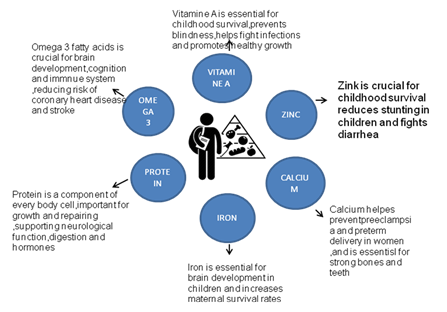Assessing the Nutritional Requirements of Farmed Fish for Optimal Growth and Development
Abstract
Farmed fish production has grown in importance as a component of supplying the world's need for seafood. It is crucial to comprehend the nutritional needs of farmed fish and give them the best diets possible to ensure their sustained growth and development. The main points of evaluating the nutritional needs of farmed fish to support their growth and development are summarized in this study. The global development community needs to meet the Goals for reducing worldwide malnutrition. Scientists from several fields are beginning to agree that fish is essential for food security and nutrition. However, this 'fish as food' viewpoint must still be reflected in financial priorities for innovation or regulations. When viewed from the point of view of the food system, fish can inspire creative initiatives and expenditures that support nutrient- Conscious and socially just aquaculture and catch fishing. The usual view of fish as a natural resource, which emphasizes aims for economic growth and biodiversity protection, contrasts with this. The research requirements and policy directions for achieving this are highlighted in this study. Recognizing and enhancing the significance of fish in lowering malnutrition and starvation is necessary for investments to be made in capture farming and fishing by governments, international development organizations, and society. Besides financial gain and wildlife preservation, this will offer further long-term growth motivation.
References
[2] Shoko, A.P., Limbu, S.M., Lamtane, H.A., Kishe-Machumu, M.A., Sekadende, B., Ulotu, E.E., Masanja, J.C. and Mgaya, Y.D., 2019. The role of fish-poultry integration on fish growth performance, yields, and economic benefits among smallholder farmers in sub-Saharan Africa, Tanzania. African Journal of Aquatic Science, 44(1), pp.15-24.
[3] Li, X., Yadav, R. and Siddique, K.H., 2020. Neglected and underutilized crop species: the key to improving dietary diversity and fighting hunger and malnutrition in Asia and the Pacific. Frontiers in NutritionNutrition, 7, p.593711.
[4] Toni, M., Manciocco, A., Angiulli, E., Alleva, E., Cioni, C. and Malavasi, S., 2019. We assess fish welfare in research and aquaculture, focusing on European directives. Animal, 13(1), pp.161-170.
[5] Karimi, S., Mahboobi Soofiani, N., Lundh, T., Mahboubi, A., Kiessling, A. and Taherzadeh, M.J., 2019. Evaluation of filamentous fungal biomass cultivated on vinasse as an alternative nutrient source of fish feed: protein, lipid, and mineral composition. Fermentation, 5(4), p.99.
[6] Roques, S., Deborde, C., Richard, N., Skiba‐Cassy, S., Moing, A. and Fauconneau, B., 2020. Metabolomics and fish nutrition: a review in the context of sustainable feed development. Reviews in Aquaculture, 12(1), pp.261-282.
[7] Mohanty, B.P., Mahanty, A., Ganguly, S., Mitra, T., Karunakaran, D. and Anandan, R., 2019. Food fishes' Nutritional composition and importance in providing food and nutritional security. Food Chemistry, 293, pp.561-570.
[8] Hersoug, B., Mikkelsen, E. and Karlsen, K.M., 2019. "Great Expectations"–Allocating licenses with special requirements in Norwegian salmon farming. Marine Policy, 100, pp.152-162.
[9] Sogari, G., Amato, M., Biasato, I., Chiesa, S. and Gasco, L., 2019. The potential role of insects as feed: A multi-perspective review. Animals, 9(4), p.119.
[10] Visconti, P., de Fazio, R., Velázquez, R., Del-Valle-Soto, C. and Giannoccaro, N.I., 2020. Development of a sensors-based agri-food traceability system remotely managed by a software platform for optimized farm management. Sensors, 20(13), p.3632.
[11] Dalton, G., Bardócz, T., Blanch, M., Campbell, D., Johnson, K., Lawrence, G., Lilas, T., Friis-Madsen, E., Neumann, F., Nikitas, N. and Ortega, S.T., 2019. Feasibility of investment in Blue Growth multiple-use of space and multi-use platform projects; results of a novel assessment approach and case studies. Renewable and Sustainable Energy Reviews, 107, pp.338-359.
[12] Hu, F., Zhong, H., Wu, C., Wang, S., Guo, Z., Tao, M., Zhang, C., Gong, D., Gao, X., Tang, C. and Wei, Z., 2021. Development of fisheries in China. Reproduction and Breeding, 1(1), pp.64-79.
[13] Njiru, J.M., Aura, C.M. and Okechi, J.K., 2019. Cage fish culture in Lake Victoria: A boon or a disaster in waiting? Fisheries Management and Ecology, 26(5), pp.426-434.
[14] Freitas, J., Vaz-Pires, P. and Câmara, J.S., 2020. From aquaculture production to consumption: Freshness, safety, traceability and authentication, the four pillars of quality. Aquaculture, 518, p.734857.
[15] Hawkey, K.J., Lopez-Viso, C., Brameld, J.M., Parr, T. and Salter, A.M., 2021. Insects: a potential source of protein and other nutrients for feed and food. Annual review of animal biosciences, 9, pp.333-354.







